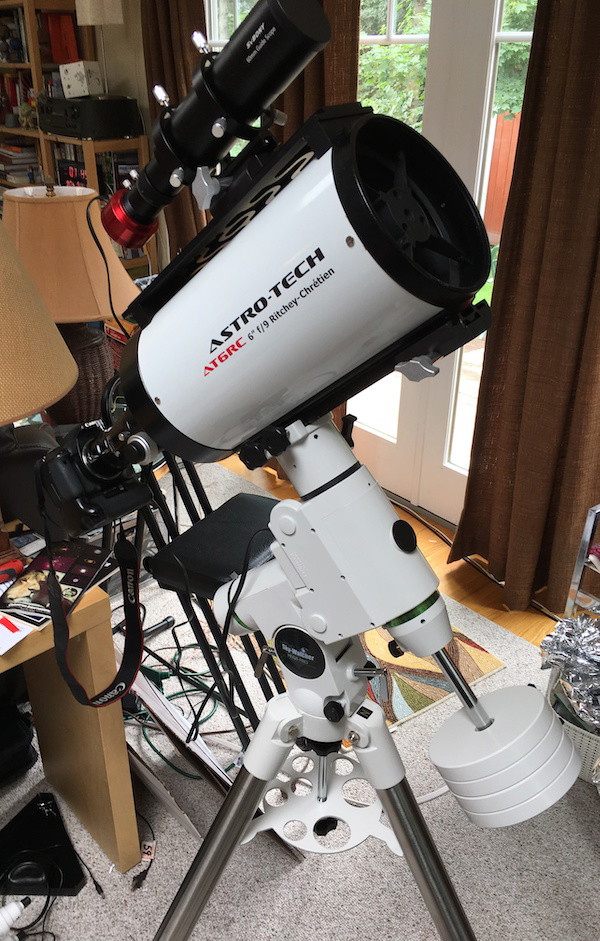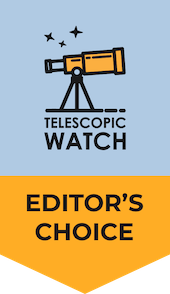Technical Specs
The HEQ5i Pro (an updated version of the HEQ5 Pro) has a stated weight capacity of 30 pounds for visual use and 24 pounds for astrophotography. In my practical experience, anything much heavier than 20 pounds loaded atop the HEQ5i Pro for visual or planetary imaging use is shaky and puts a lot of strain on the gears. Also, anything heavier than 16 pounds for astrophotography results in poor guiding and blurry images even if I use it with relatively short exposures.
The HEQ5i Pro can hold any scope with a Vixen-style dovetail bar attached to the scope’s bottom side. If your telescope doesn’t already have one, the mount comes with a short, green Vixen-style dovetail that you can attach. However, the stock saddle is not my favorite as it uses two screws that mar the dovetail, making it a little hard for me to adjust balance on the declination axis. I would recommend upgrading the saddle to a nicer one if you have the funds to do so.
Being a Chinese-made, relatively inexpensive mount rather than an unobtainium magic instrument costing as much as an apartment, the HEQ5 Pro uses relatively cheap stepper motors and gears to track the sky and slew around. Of course, I’m not saying that it doesn’t cause some periodic errors and backlash. There are some belt mod/tuning kits available to improve tracking, and of course, most tracking errors can be solved with autoguiding anyway. The more expensive Sky-Watcher models, such as the AZ-EQ5i Pro and the larger EQ6Ri Pro, offer belt drives included by default, unlike the HEQ5i Pro.
The HEQ5i Pro includes two 11-pound counterweights. These attach to its ¾” counterweight shaft, which I can retract inside the body when the mount is not in use. I also got a built-in illuminated polar scope and a DC power cord by default with the purchase.
Software Compatibility
You can control the HEQ5i Pro with the SynScan app for astrophotography, but I would recommend plugging it into your computer with an EQDIRECT cable. You can then control the entire setup with NINA, Sequence Generator Pro, or other imaging/capture software, provided you install the ASCOM drivers, EQMod, and PHD2 first.
NINA allows me to plate-solve for extremely accurate alignment, and once I iron out any bugs that could occur with my whole setup, I can just put the scope together, polar align, focus, and tell NINA what I want to shoot (it can even do multiple targets). NINA does exactly what I programmed, even including a meridian flip. I can go to sleep, watch television, or do visual astronomy as it shoots my astrophotos completely autonomously—I just make sure to provide sufficient power for the whole setup with AC power or a large 12v marine battery.
Using HEQ5i Pro For Visual Astronomy & Planetary Imaging
If you’re looking for a lightweight, portable, and computerized mount to carry your Celestron C8 optical tube or a similarly small/lightweight telescope weighing under 15-20 pounds in total, I’m pretty sure that the HEQ5 Pro would be great. However, if you are looking to get the most mount capacity for your money, there are a couple of better options with more capacity.
The HEQ5 Pro was noticeably a little overweight when I used it with one of my 8” Cassegrain and 5-6” refractor. It also couldn’t hold an 8” Newtonian reflector and above. A 6” Newtonian/Cassegrain or 4” refractor is about as much as I would recommend loading on the mount.
Setting up the HEQ5 Pro for visual astronomy was pretty simple for me:
- I first got the mount leveled, then put the telescope and counterweights on. Careful balancing is not as crucial as with astrophotography, but poor balancing will wear out the mount’s gears, so I’d advise you to try your best.
- Once that’s done, I rotate the scope 90 degrees on the declination axis (so that it’s pointing near the horizon) and look through the polar scope with the aim of getting the outer circle in the polar scope’s reticle closely aligned with Polaris.
- Then I boot up the mount and star align it as with any computerized mount, using my smartphone/tablet and a suitable app connected over WiFi to control the HEQ5i Pro. The SynScan app also allows me to do a polar alignment without looking through the polar scope if need be; another app like SkySafari doesn’t have this feature but otherwise has a superior interface and database.
Using HEQ5i Pro For Deep-Sky Astrophotography
The HEQ5 Pro of course has an autoguide port, so a guide camera can interface with it, and you can control most guide cameras with PHD2 (“Push Here Dummy”) on most laptops.
When I tried using the HEQ5 mount without guiding, its tracking errors resulted in blurred subframes on most scopes with anything longer than 30-45 seconds of exposure. With autoguiding, I was able to achieve accuracy of 0.9 arcseconds, shoot 3-minute subframes with a 3″ f/8 refractor and still get perfect stars, and shoot up to 90 seconds with a 6″ f/9 Ritchey-Chretien and still get good results. But I believe that the 6” Ritchey is really maxing out the mount’s capabilities, and so I would recommend you upgrade to a bigger mount if a scope with over 1000mm of focal length is really something you want to shoot with often.

Software like NINA can run PHD2 for you and auto-select stars, so you don’t have to if you are interested in a totally automated setup.
Below are three photos that I shot with my HEQ5i Pro, my Takahashi FC-76 (a 3” f/8 ED doublet refractor), a field flattener, a full-spectrum modified Canon T3i, and autoguiding with a 50mm guide scope and ZWO ASI224MC:



Should I buy a Used Sky-Watcher HEQ5i Pro?
I’d confidently state that a used HEQ5i Pro or HEQ5 Pro would be an excellent choice for a mount. You can easily upgrade an older HEQ5 to an HEQ5i with Sky-Watcher’s WiFi adapter or to a newer SynScan controller. The now-defunct Orion Sirius EQ-G is also identical. The non-Pro HEQ5 is a manual mount, however, and is extremely hard to upgrade to GoTo and thus should be avoided.
As always, make sure that the HEQ5/5i Pro functions and tracks well before purchasing. Missing counterweights or knobs are easily replaced, and it’s also easy to find a new (and arguably steadier) tripod from a Celestron, Sky-Watcher, or Orion mount to put it on.
Alternative Recommendations
The HEQ5i Pro is my top pick in its price range. However, here are some other options I might recommend considering.
Under $1500
- The Sky-Watcher EQM-35i Pro shares many of the HEQ5i’s features, such as stepper motors, but has less payload capacity and slightly inferior mechanics, which bring its tracking/guiding accuracy down. It is also less compact.
- The Celestron Advanced VX is capable of carrying much heavier loads than the HEQ5i or EQM-35i for visual use or planetary imaging, but its low-quality servo motors, inferior mechanics, and inferior software/hardware interfaces make it a poor choice for deep-sky astrophotography.
- The Sky-Watcher Star Adventurer GTi features FreedomFind encoders allowing for manual aiming, along with a built-in battery pack, USB port, and compactible design, but is even lighter duty than the EQM-35i Pro and uses lower-quality servo motors instead of steppers.
$1500+
- The Sky-Watcher EQ6Ri Pro shares many of the features of the HEQ5i Pro but with nearly double the weight capacity and belt drives added in by default. It’s our top pick for a mount overall behind the slightly superior AZ-EQ6i.
- The Sky-Watcher AZ-EQ6i is largely identical to the EQ6Ri Pro but adds the ability to be aimed manually with the Sky-Watcher FreedomFind encoder technology, can be converted to an alt-azimuth mount, and has a USB port in the side for easy PC connection instead of requiring an additional adapter and cable.
- The Sky-Watcher AZ-EQ5i is based on the HEQ5i Pro but adds the ability to be converted to an alt-azimuth mount and hold two telescopes at once, as well as a belt drive upgrade, USB port, and FreedomFind encoders to allow for manual aiming.



Hi Zane,
you state that
“If you’re looking for a lightweight, portable and computerized mount to carry your C8 or similar, the HEQ5 Pro is great. However, if you are looking to get the most mount capacity for your money, there are a couple of better options with more capacity.”
Can you elaborate on that? What are the better options here?
Thank you
Zwent
The Celestron Advanced VX and CGEM can hold a fair bit more weight but they’re inferior to the HEQ5 and EQ6R for astrophotography
Zane,
I’m looking for a good mount for a redcat 51 for AP use, with some possibility of future OTA use. I’ve been leaning towards the HEQ5. Does the EQ6-R provide any advantage other than payload capacity? Also, any other mounts you would recommend? Thanks for detailed review.
The EQ6R provides a lot more payload capacity but with the RedCat it makes really no difference.
The HEQ5 and EQ6R are my personal favorite EQ mounts for astrophotography. However, I would personally consider getting something besides the RedCat – I’ve heard mixed reviews and a 60-80mm ED refractor gives you a lot more capability.
Zane,
Great article. Thank you for this. If I read this correctly in your conclusions then the HEQ5 recommended payload capacity for visual observation is about 30lbs on the telescope side of the mount. For photography about 60% of the 30lb weight is only allowed for the telescope side and the other side is counterweights. So, about 20lb photographic load maximum for this mount to achieve good long exposures (assuming polar alignment is not an issue).
My ideal setup with the HEQ is about 16 lbs on the telescope side. Do you see any issues with this loading?
I’d limit the mount to maybe 25 pounds for visual. 30 is really pushing it.
What’s the focal length of the scope you’re using? 16 pounds is fine if you’re under 1500mm or so.
Does the HEQ5i create a WiFi of it’s own or it comes with a SW WiFi dongal?
It just comes with the dongle instead of a hand controller.